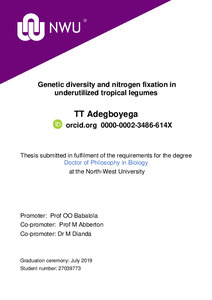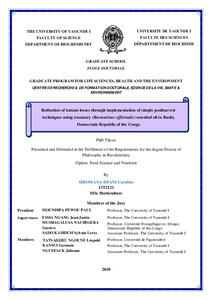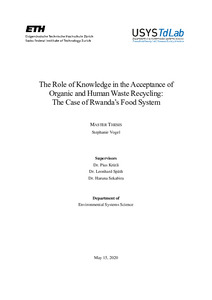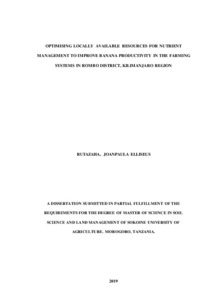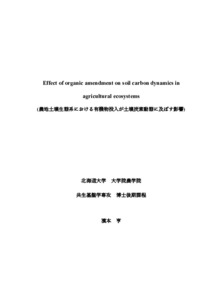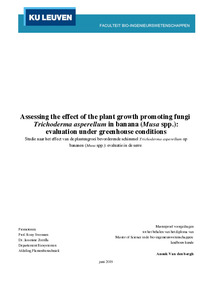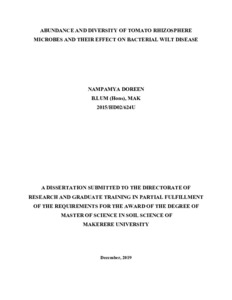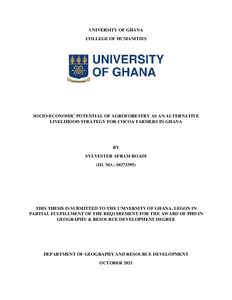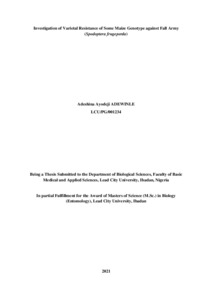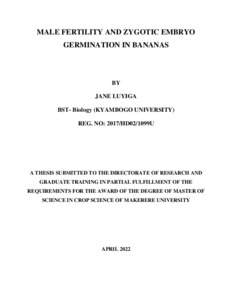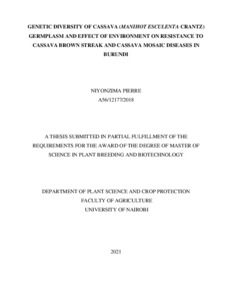Welcome to the International Institute of Tropical Agriculture Research Repository
Theses and Dissertations: Recent submissions
Now showing items 41-60 of 81
-
Cassava farmers' insights and seed dealers enterprises in Nigeria
(University of Ibadan, 2019)Seed enterprise is an initiative and risk set up in the production of cassava stems from existing local seed varieties or improved seed varieties for economically sustainable profit. Although, most cassava seeds produced are through informal seed system among smallholder farmers but there is need for replacement strategy for cassava seeds mostly planted over years. Based on this, there is need for intense exploration in the linkage between cassava seed management and diffusion scheme among rural ... -
Genetic diversity and nitrogen fixation in underutilized tropical legumes
(North-West University, 2019-07)Legumes in some cases are underutilized and form only a relatively small proportion of human diets. In general they fix atmospheric nitrogen which may provide an economic advantage for smallholder farmers. By appropriate utilization of legumes, food security and soil fertility can be significantly achieved. During the 2016/2017 and 2017/2018 cropping seasons at the International Institute of Tropical Agriculture (IITA) Ibadan, Nigeria, field and laboratory experiments were conducted to determine ... -
Reduction of tomato losses through implementation of simple postharvest techniques using rosemary (Rosmarinus officinalis) essential oil in Bushi, Democratic Republic of the Congo
(University of Yaounde, 2020)Tomato is perishable and its high moisture content makes it susceptible for various postharvest losses. Tomato quality changes continuously after harvesting when fruits start losing quality because of environmental stress and pathogen infection. Thus, the objective of this research was to propose simple postharvest technology using rosemary essential oil (REO) to reduce postharvest decay. This was done by conducting a field survey in order to determine agricultural potential of soil and environmental ... -
The role of knowledge in the acceptance of organic and human waste recycling: the case of Rwanda's food system
(Swiss Federal Institute of Technology, 2020-05-15)By 2050, the world’s population is expected to increase to 9 billion people. The growing population intensifies urbanization, which puts pressure on the current challenges of food insecurity and environmental pollution. In Rwanda, rural migration and the lack of financial capital to apply sufficient fertilizer result in nutrient-deficient agricultural soils which lead to a decrease in food production. Moreover, the rapid urban expansion leads to environmental pollution and human health risks from ... -
Optimising locally available resources for nutrient management to improve banana productivity in the farming systems in Rombo District, Kilimanjaro region
(Sokoine University of Agriculture, 2019)Banana is an important staple food in East Africa and an essential cash crop in the national and local economies. In Kagera and Kilimanjaro regions of Tanzania, banana is cultivated by more than 70% of smallholder farmers as a staple food in home gardens ranging from 0.5 to 2 hectares. Decline in banana yield has been reported in banana farming systems as a result of abiotic constraints (nutrient deficiencies and drought stress) and biotic constraints (pests and diseases). Decline in soil fertility ... -
Socio economic and botanic analysis of West Bank and Block A Forest of International Institute of Tropical Agriculture (IITA), Ibadan, Oyo State, Nigeria
(Federal University of Agriculture, Abeokuta, 2018-09)Forests are community of plants (vegetation) dominated by trees and are crucial to the welfare of man. Socio- economic and botanic analysis of West Bank and Block A Forests of International Institute of Tropical Agriculture (IITA) was undertaken with the aim of determining the uses, structure, composition, similarity, extent of diversity of the forests, types and quantity of non- timber forest products (NTFPs) collected from the forests. The determinants of medicinal plants usage and intensity ... -
Effect of organic amendment on soil carbon dynamics in agricultural ecosystems
(Hokkaido University, 2020-03-25)Soil carbon (C) contents and dynamics are important in the maintenance of health soils. Organic amendments (e.g. crop residue and organic manure) are known as materials to increase soil C. The degradation of organic amendments and physical disturbance of soils, performed by the fauna, can alter soil microbial community, and thus influence rates of the C cycles. However, little is known about the interaction between different soil biological communities (i.e. soil fauna and microbes) regarding soil ... -
Equal and inclusive opportunity to access and use of ICT-based crop extension services for farm-level actors in Rwanda: a case study of the ICT4BXW project
(Wageningen University and Research Center, 2020-03-31)All farmers around the world have a need for information. Information communication technology (ICT) could make access to information easier (Palumbo, 2013) (Aker & Mbiti, 2010) (van Winden, 2011). Others do however claim that the use of ICT excludes certain users from accessing information (Diga, Fortune, & Plantinga, 2013) (Njoki & Wabwoba, 2014) (Waugaman, 2016). Not only the use of ICT but also the design of the ICT platform could exclude users from access to information (Clarkson, Dong, & ... -
Nematode biodiversity in south-western Nigerian watermelon cropping systems, with reference to Meloidogyne and its management
(North-West University, 2020-05)Watermelon is increasingly produced and consumed in Nigeria and sub-Saharan Africa (SSA). However, limited information exists regarding the nematode fauna associated with the crop. Therefore, the overall aim of this study was to determine the nematode assemblages associated with watermelon, to investigate the reproduction potential of populations of the predominant plant-parasitic nematodes identified and to assess the host status of commercially available cultivars in south-west Nigeria to the ... -
Site-specific nutrient management advice and agricultural intensification in maize-based systems in Nigeria
(Katholieke Universiteit Leuven, 2019-12)Despite the potentially large gains from intensification and agricultural productivity growth in Sub-Saharan Africa (SSA), yields of staple crops, such as maize are far below attainable yields. Depletion of soil fertility associated with low and inappropriate use of nutrients play a crucial role in this. Yet, fertilizer use is low in SSA, which partly relates to information constraints. Relaxing such constraints via agricultural extension interventions is expected to produce positive outcomes but ... -
Assessing the effect of the plant growth promoting fungi Trichoderma asperellum in banana (Musa spp.): evaluation under greenhouse conditions
(Katholieke Universiteit Leuven, 2019-06)Bananas (Musa spp.) are one of the most important crops in the global food crop industry, the second most important fruit crop and an important staple crop around the world. Due to the increased trend in global population, a raise in the intensity in crop productivity is needed. The use of plant growth-promoting microorganisms (PGPM) could be an alternative to improve the stress-tolerance and productivity of crops, thus, reducing the amount of chemical pesticides and fertilizers needed. Trichoderma ... -
Soil fertility mapping and development of nutrient management zones in maize-based cropping system of the savanna zone of Nigeria
(Bayero University, 2019-07)There is a growing need for spatially continuous and quantitative soil information for improved farmers yields and environmental management. This study was aimed at mapping the spatial variability of soil properties with focus on delineating soil nutrient management zones (MZs) in a maize-based cropping system. Farmers’ fertilizer application rates were monitored in relation to the yield obtained. The study was conducted in Ikara, Soba, Doguwa, Bunkure, Faskari, Kankara, Malumfashi, Bakori, Kafur, ... -
Abundance and diversity of tomato rhizosphere microbes and their effect on bacterial wilt disease
(Makerere University, 2019-12)The use of land for agricultural production is always accompanied with changes in microbial diversity and emergency of new pathogens. Microbial imbalances and unevenness have enhanced multiplication of pathogens and proliferation of many soil borne diseases, which are tedious to control. Biocontrols are promising and environmentally friendly agents against such diseases. However, microbiome composition and land use management have been mentioned as core factors in effectiveness of biocontrols. ... -
Socio-economic potential of agroforestry as an alternative livelihood strategy for cocoa farmers in Ghana
(University of Ghana, 2021-10)Cocoa (Theobroma cacao) cultivation in Ghana is dominated by smallholder farming households most of whom derive the greater percentage of their incomes from the crop. Changes in climate in addition to inherent boom-and-bust cycles associated with cash cropping is reducing the yielding capacity of cocoa plots and, by extension, household incomes. Current research suggests that the integration of trees and other crops into cocoa plots has the potential to increase the resilience of these farms to ... -
Investigation of varietal resistance of some maize genotype against fall army (Spodoptera frugeperda)
(Lead City University, 2021)The fall armyworm (FAW) has recently invaded and established itself as a major maize pest in Africa, causing yield losses of up to a third of annual maize production. The current study assessed several elements of resistance to FAW larvae feeding of 48 maize hybrids developed by IITA scientists in the laboratory, screen house, and field. The arrest and feeding of FAW neonate larvae in no-choice and choice trials, the growth of larvae-pupae in laboratory circumstances, and plant damage in a field ... -
Male fertility and zygotic embryo germination in bananas
(Makerere University, 2022-04)Crop improvement through crossbreeding relies on the generation of new hybrids from seeds. Therefore, seed set and seed germination are key determining factors for a successful breeding program. In banana breeding, both seed set and seed germination are low, especially in triploid and tetraploid bananas. To improve germination, embryos are extracted from seeds and cultured in vitro. Seed set is determined by the quantity and viability of pollen for the male parents, or male fertility, and by the ... -
Factors influencing the decision of cassava farmers to sell or process roots in selected states of southwest, Nigeria
(2022-05)Cassava farmers are faced with the decision to either sell or process the roots of the crop. However, the factors affecting this decision are largely unknown. Three hundred and six cassava farmers were interviewed, with the objectives to (i) profile the socio-economic characteristics of farmers (ii) examine the price trend between January, 2019 to August, 2020, (iii) costs and returns of the farmers who sell roots and cassava products, (iv)profile the risks and mitigating strategies used by farmers ... -
Occurrence, abundance and distribution of nematodes of banana linked to altitude in selected banana production areas with focus on pathogenicity of Pratylenchus goodeyi in Kenya
(Kenyatta University, 2022-06)Banana (Musa spp.) is a popular fruit crop in Kenya, where it is largely cultivated by smallholder farmers. However, plant pathogens, such as plant parasitic nematodes, have been blamed for the fall in output (PPN). A survey of bananabased subsistence farming systems in Kenya's banana-growing counties was done with the objective to a) assess farmers' awareness regarding PPN, b) explore the variability regarding PPN species associated with banana genotypes in Kenya and if the prevalence and abundance ... -
Potential use of denitrifying bacteria in reduction of nitrogenous compounds in the effluent discharged into lake Victoria, Kenya
(University of Embu, 2022-04)Nutrient loading with nitrogen and phosphorus in receiving waters is an increasing concern worldwide. In Lake Victoria basin, the substantial inflow of nutrients has led to intensive eutrophication of the lake. This has negatively affected not only the economic but also aesthetic as well as ecological functions. Nitrogen cycle in the atmosphere is driven by symbiotic and free-living microorganisms, which reduces dinitrogen gas to bioavailable ammonia. Ammonia is oxidized completely by a two-step ... -
Genetic diversity of cassava (Manihot esculanta crantz) germplasm and effect of environment on resistance to Cassava Brown Streak and Cassava Mosaic Diseases in Burundi
(University of Nairobi, 2021)Cassava is an important cash crop for many small scale farmers in Burundi. Most small scale farmers use local landraces and though they have farmer preferred traits, their genetic diversity is unknown and marred by phenotypic susceptibility to Cassava Brown Streak Disease (CBSD) and Cassava Mosaic Disease (CMD). This limits future breeding programs to improve cassava production and resistance to diseases in Burundi. Due to this, disease tolerant genotypes from other countries were introduced to ...


